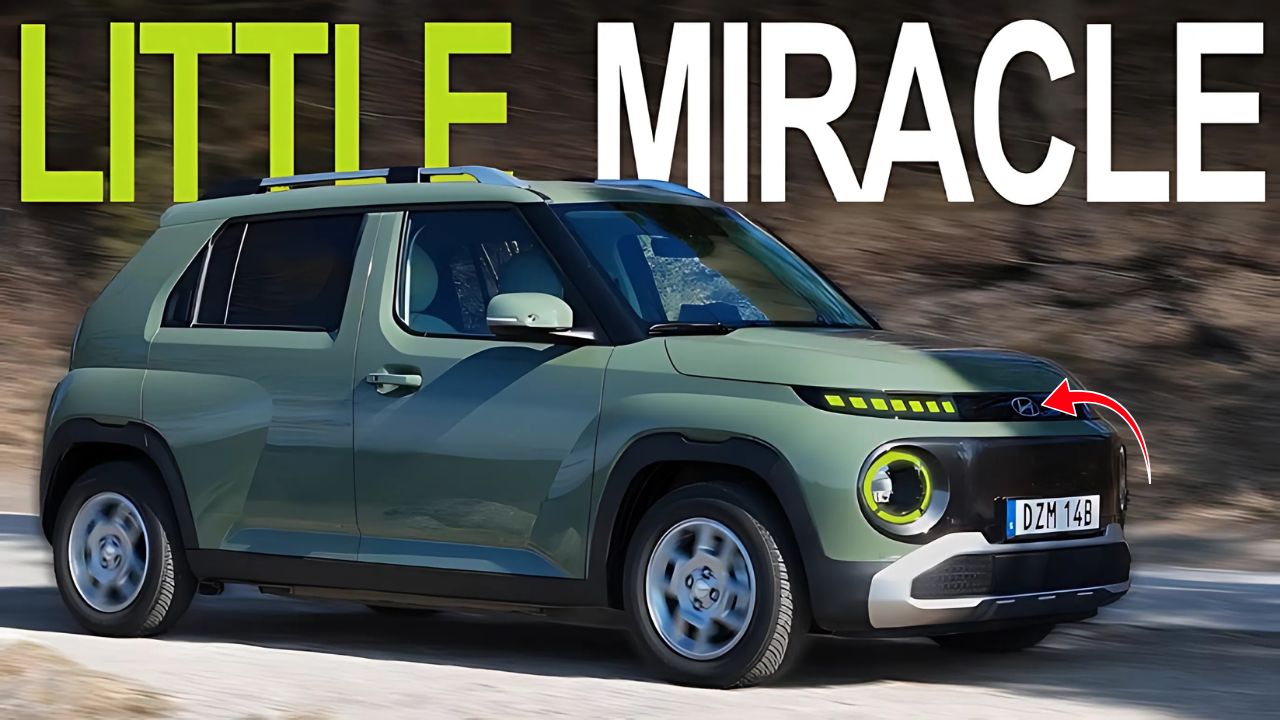Two compelling electric vehicles are reshaping the budget EV landscape. Both the Hyundai Inster and Smart #5 promise practical range without premium pricing.
These models target drivers who want electric mobility without sacrificing convenience. Their similar range capabilities make choosing between them genuinely challenging.

Design Philosophy and Brand Approach
Hyundai brings decades of automotive experience to the Inster project. Their approach emphasizes reliability and practical functionality over flashy innovations.
Smart, traditionally known for city cars, expands its vision with the #5. This model represents their evolution toward mainstream electric vehicle markets.
Exterior Styling Differences
The Inster follows Hyundai’s current design language with clean, purposeful lines. Aerodynamic efficiency takes priority over dramatic styling elements.
Smart #5 maintains some playful design cues while growing more sophisticated. The brand’s heritage influences certain details without overwhelming the overall appearance.
Interior Space and Functionality
Hyundai maximizes interior room through efficient packaging techniques. The Inster offers surprising passenger space despite its compact exterior dimensions.
Smart #5 balances urban maneuverability with passenger comfort effectively. Interior materials reflect the brand’s premium aspirations while controlling costs.
Performance Comparison Analysis
Both vehicles deliver adequate power for daily driving situations. Neither prioritizes high performance, focusing instead on efficiency and practicality.
Electric motor characteristics provide smooth acceleration in urban environments. Highway performance meets expectations without exceeding them dramatically.
Acceleration and Driving Dynamics
The Inster accelerates predictably with linear power delivery. Hyundai’s tuning emphasizes comfort over sporty characteristics.
Smart #5 offers slightly more responsive throttle mapping. The driving experience feels more engaging during city navigation.
Handling and Ride Quality
Hyundai’s suspension tuning prioritizes ride comfort over sharp handling. The Inster absorbs road imperfections effectively.
Smart engineers balance agility with comfort successfully. The #5 feels more nimble in tight spaces while maintaining reasonable comfort.
Range and Charging Infrastructure Compatibility
Both models exceed 370 kilometers of practical range consistently. Real-world conditions reduce these figures, but daily driving needs remain covered.
Charging compatibility includes standard DC fast charging protocols. Neither vehicle requires special charging equipment beyond industry standards.
Battery Technology and Management
Hyundai uses proven battery chemistry with conservative management strategies. This approach prioritizes longevity over maximum performance.
Smart employs similar battery technology with slightly different thermal management. Their system optimizes for urban driving patterns specifically.
Charging Speed and Convenience
The Inster charges at moderate speeds suitable for overnight home charging. DC fast charging provides reasonable road trip capabilities.
Smart #5 charging speeds match competitive vehicles closely. Urban charging infrastructure works well with both models.
Technology Integration and Features
Modern connectivity features appear in both vehicles as standard equipment. Neither brand skimps on essential technology to maintain competitive pricing.
User interface design reflects each brand’s philosophy toward driver interaction. Both systems avoid unnecessary complexity.
Infotainment Systems Comparison
Hyundai’s system builds on their established interface design principles. Familiar controls reduce learning curves for existing customers.
Smart’s infotainment reflects their European design sensibilities. The interface feels modern without abandoning functional priorities.
Driver Assistance and Safety Features
Both vehicles include comprehensive safety packages as standard equipment. Advanced driver assistance systems work reliably in typical situations.
Emergency braking and collision warning systems perform comparably. Neither vehicle compromises safety to achieve target pricing.
Pricing Strategy and Value Analysis
Both manufacturers target similar price points deliberately. This creates direct competition that benefits potential buyers significantly.
Value propositions differ subtly despite similar pricing structures. Each brand emphasizes different aspects of the ownership experience.
Standard Equipment Levels
Hyundai includes generous standard equipment reflecting their mainstream approach. Base models avoid feeling stripped-down or incomplete.
Smart #5 standard features lean toward premium touches. Even entry-level models include elements that enhance daily usability.
Optional Equipment and Customization
The Inster offers practical options that enhance functionality without excessive cost. Hyundai focuses on useful additions rather than luxury items.
Smart provides more personalization options reflecting their brand character. Customization choices allow owners to express individual preferences.
Market Position and Target Customers
First-time electric vehicle buyers represent primary target customers for both models. Neither vehicle intimidates newcomers to electric mobility.
Budget-conscious drivers appreciate the combination of features and pricing. Both models make electric driving accessible to broader customer segments.
Urban vs. Suburban Suitability
The Inster works well in suburban environments with longer commutes. Hyundai’s approach suits drivers who prioritize comfort and reliability.
Smart #5 excels in urban environments where maneuverability matters most. City driving scenarios highlight the vehicle’s strengths effectively.
Family Considerations
Hyundai’s reputation for reliability appeals to family buyers. The Inster provides practical transportation without unnecessary complications.
Smart #5 attracts younger buyers who value style alongside functionality. The brand image resonates with urban professionals particularly.
Ownership Experience Expectations
Service network availability favors Hyundai in most global markets. Established dealer networks provide convenient maintenance access.
Smart’s service network requires more research in certain regions. Urban areas typically offer better service accessibility than rural locations.
Maintenance Requirements and Costs
Both vehicles require minimal routine maintenance compared to gasoline cars. Electric drivetrains reduce service frequency and complexity.
Parts availability should favor Hyundai initially due to production volumes. Smart parts may cost more but should remain reasonably available.
Warranty Coverage Comparison
Hyundai offers comprehensive warranty coverage matching their traditional vehicles. Battery warranties provide long-term peace of mind.
Smart warranty terms remain competitive within industry standards. Coverage levels protect buyers from unexpected repair expenses.
Environmental Impact and Efficiency
Both models achieve excellent efficiency ratings in their class. Electric drivetrains eliminate local emissions during operation.
Manufacturing environmental impact varies based on production location and methods. Both brands emphasize sustainable manufacturing practices.
Energy Consumption Patterns
Real-world energy consumption varies with driving style and conditions. Both vehicles perform well in efficiency testing protocols.
Cold weather impacts both models similarly. Battery heating systems maintain performance while reducing overall range.
Lifecycle Environmental Considerations
Battery recycling programs exist for both vehicles. End-of-life environmental impact depends on local recycling infrastructure.
Total environmental benefits depend on local electricity generation methods. Clean energy grids maximize environmental advantages.
Future Model Development

Both brands plan to build additional electric vehicles, building on these models’ success. Future improvements will likely focus on cost reduction and feature enhancement.
Technology advancement will benefit both models through software updates. Hardware limitations may require new model generations eventually.
Anticipated Improvements
Battery technology advances should improve range and charging speed. Cost reductions may allow additional features at similar price points.
Manufacturing experience will likely improve build quality and reduce costs. Both brands benefit from electric vehicle production learning curves.
Market Evolution Impact
Increasing competition will pressure both manufacturers to enhance value propositions. Consumer benefits include better features and lower prices.
Infrastructure improvements will enhance both vehicles’ practicality. Expanded charging networks reduce range anxiety concerns.
FAQs
Which vehicle offers better value for money?
Both offer excellent value, but Hyundai Inster provides more standard features while Smart #5 offers superior urban maneuverability.
How do charging speeds compare between these models?
Charging speeds are nearly identical, with both vehicles supporting standard DC fast charging up to 80kW.
Which vehicle is better for family use?
The Hyundai Inster offers more interior space and storage, making it more suitable for families with children.

